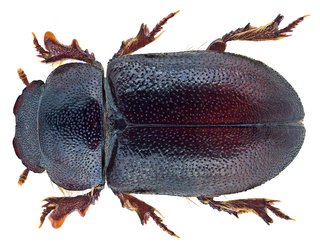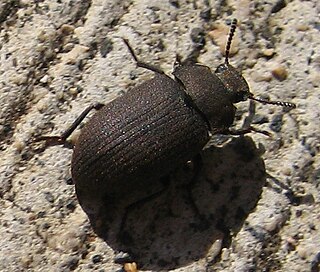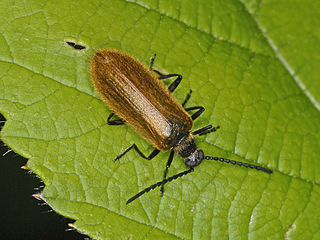| Cnodalon | |
|---|---|
 | |
| Cnodalon viride | |
| Scientific classification | |
| Kingdom: | |
| Phylum: | |
| Class: | |
| Order: | |
| Family: | |
| Subfamily: | |
| Tribe: | |
| Genus: | Cnodalon Latreille, 1796 |
Cnodalon is a genus of darkling beetles in the family Tenebrionidae. [1]
| Cnodalon | |
|---|---|
 | |
| Cnodalon viride | |
| Scientific classification | |
| Kingdom: | |
| Phylum: | |
| Class: | |
| Order: | |
| Family: | |
| Subfamily: | |
| Tribe: | |
| Genus: | Cnodalon Latreille, 1796 |
Cnodalon is a genus of darkling beetles in the family Tenebrionidae. [1]
Species within this genus include: [2]

Darkling beetle is the common name for members of the beetle family Tenebrionidae, comprising over 20,000 species in a cosmopolitan distribution.

Eleodes is a genus of darkling beetles, in the family Tenebrionidae. They are endemic to western North America ranging from southern Canada to central Mexico with many species found along the Mexico-United States border. Some species have been introduced to Colombia. The name pinacate is Mexican Spanish, derived from the Nahuatl (Aztec) name for the insect, pinacatl, which translates as "black beetle."

Tenebrioninae is the largest subfamily of the darkling beetles (Tenebrionidae), containing flour beetles, among others. Tenebrioninae contains more than 20 tribes.

Cheirodes is a genus of darkling beetles in the Melanimonini tribe. It was formerly known as Anemia until 1973, when T. J. Spilman determined Anemia to be a synonym of CheirodesGéné, 1839.

Lobopoda is a genus of comb-clawed beetles in the family Tenebrionidae. The type species is Lobopoda striata. The following subgenera of Lobopoda have been described:

Opatrini is a tribe of darkling beetles (Tenebrionidae) in the subfamily Tenebrioninae.
Trachelostenus is a genus of darkling beetles in the family Tenebrionidae. It is native to the Valdivian forests of Chile, and has at least two species, T. inaequalis (Solier) and T. fascicularis (Philipp). It was historically considered the only member of the family Trachelostenidae, but a 2015 study sunk the genus into the tenebrionid subfamily Tenebrioninae.

Alleculinae is a subfamily of comb-clawed beetles belonging to the family Tenebrionidae. These beetles are characterized by an oval body, threadlike antennae, relatively long legs and tarsi quite elongated. Their most striking feature, however, are the combed claws of the hind tarsi, that show fine teeth.

Lagria is a genus of beetles in the family Tenebrionidae.

Cnodalon viride is a species of darkling beetles in the family Tenebrionidae.

Diaperinae is a subfamily of darkling beetles in the family Tenebrionidae. There are more than 120 genera in Diaperinae, grouped into 11 tribes.

Lagriinae is a subfamily of long-jointed beetles in the family Tenebrionidae. There are more than 270 genera in Lagriinae, grouped into 11 tribes.

Adesmia is a genus of beetles in the family Tenebrionidae. This includes the Pitted beetle
Aphanotus is a genus of darkling beetles in the family Tenebrionidae. Species in this genus were previously within Tribolium but placed in the genus Aphanotus following phylogenetic evidence.

Mimopeus is a genus of darkling beetles in the family Tenebrionidae, first described by Francis Polkinghorne Pascoe in 1866. It is endemic to New Zealand.

Blaptinae is a subfamily of darkling beetles in the family Tenebrionidae. There are around 300 genera in Blaptinae, divided into 7 tribes.
Boromorphus is a genus of darkling beetles in the family Tenebrionidae. There are at least four described species in Boromorphus, found in the Palearctic.
Cnemodinus is a genus of darkling beetles in the family Tenebrionidae. There are at least three described species in Cnemodinus. It is the only genus in the monotypic tribe Cnemodinini.
Phrynocarenum is a genus of darkling beetles in the family Tenebrionidae, found in the Neotropics.

Metaclisa is a genus of darkling beetles in the family Tenebrionidae, the sole genus of the tribe Metaclisini. There are at least four described species in Metaclisa, found in North America, the Neotropics, the Palearctic, and Indomalaya.